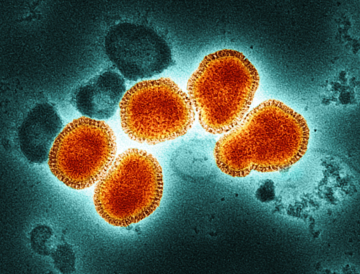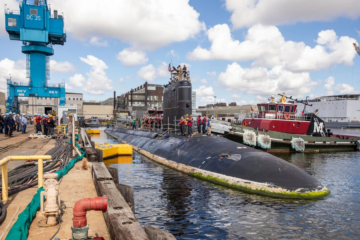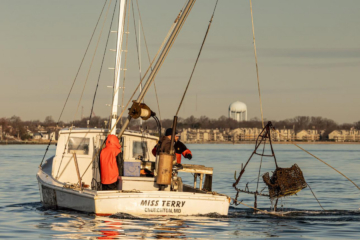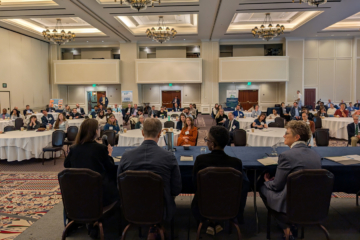After the storm
The following story originally appeared as an online exclusive on the W&M Alumni Magazine website. – Ed.
Everyone you talk to here has a story of loss and survival. We are holding the grief and the gratitude as best we can. But we sure need your light pouring into our region.
— Elizabeth “Lee” Trezise Barbour ’91, Asheville, North Carolina
Helping hands
When Hurricane Helene struck in late September, the storm triggered painful memories for Elizabeth “Lee” Trezise Barbour ’91, a resident of Asheville, North Carolina, who lived in Texas during Hurricane Harvey in 2017. She recalls hiding in the pantry with her family while tornadoes twisted through the Houston region, then being forced to evacuate for fear of a levee breach. As she observed Harvey’s impact, Barbour began writing about it on social media, where she has a significant following as a life and business coach, author and speaker.

“I was hearing all these stories about flooding and people losing their homes,” she says. “People would send me $50 or $100, or they might buy gift cards to Walmart or Target, and I was a liaison to reach people who were affected. It was all grassroots.”
She sprang into action again this fall after Helene tore through six states, causing more than 230 deaths and an estimated $250 billion in damage by flooding homes, businesses and roads. While Barbour and her family remained safe, some of the people in her professional network remembered her response to Harvey and asked how they could help the Asheville community. In early October, she also had an opportunity to speak at a writing conference in Charlotte about Helene’s impact.
“Within an hour, I’d raised $1,500. Some people sent money through Venmo and we passed around a coffee cup and people were putting cash in it,” she says. “After that, I started sharing stories on Facebook every day. Friends from all over the country were sending me money.”
One immediate need was for buckets, since Asheville lacked running water for weeks after the storm, so Barbour purchased about two dozen 5-gallon buckets during her stay in Charlotte. She also provided emergency funds to Asheville residents facing hardship.
“A woman approached me and said, ‘I’m pregnant with our second child. Our first child is about to have surgery and we can’t pay our rent because my husband lost his job, because his building is gone,’” Barbour says.
Many Asheville residents have set up Go Fund Me accounts, among them a close friend of Barbour’s whose entire home was swept away by the Swannanoa River.
Barbour provides updates on her website about the situation in Asheville. The city’s River Arts District, home to restaurants, breweries and art studios, has been particularly hard hit, she says. The Biltmore Estate, a big tourism draw for the region, was closed for about a month because of hurricane damage.
With the holiday season in mind, Barbour created a gift guide that includes links to local relief efforts, small businesses and an online marketplace organized by the area’s tourism authority to support local businesses.
“We’re trying to get people to do Christmas shopping with Asheville artists or purchase gift cards for restaurants or hotels,” she says. “That’s a great way to support the community.”
Restoring connection
Like Barbour, Steve Newman ’94 and his family survived Hurricane Helene with their home intact, and like other Asheville residents, they managed without running water for about three weeks and without drinkable water for 53 days. Schools were closed for a month. Community care stations provided hot meals and shower and laundry facilities.

As director of development for Asheville-based fiber optic network provider ERC Broadband, Newman’s most pressing concern has been maintaining internet connection for the community — including hospitals, emergency services, businesses and local government offices — and restoring service to affected areas.
Before running water was restored, trucks had to haul water from a nearby lake to a tank at the downtown Asheville building that houses ERC’s offices to supply the cooling system, which enables the company’s data center to operate. Newman and his colleagues took turns monitoring water levels around the clock. Beyond those immediate challenges, the company faces the daunting task of rebuilding its 1,700-mile fiber cable network.
“This network was put in place over 24 years and in large segments, the fiber is just gone,” says Newman, who helps connect W&M alumni as the 1994 class reporter. “This storm erased hundreds of miles of our fiber and our infrastructure.”
Each mile of fiber cable costs about $55,000 to install, he says, estimating that immediate recovery efforts will require an investment of up to $2 million. Restoring the network to pre-hurricane conditions could cost $5 million, he adds. Because many utility poles are down, ERC has been temporarily attaching fiber optic cables to trees and buildings and placing them on the ground.
State and federal government aid is available for businesses, but it’s not enough and it doesn’t arrive right away. The Small Business Association (SBA), for example, is accepting disaster loan applications, but new loan offers are delayed until Congress approves more funding.
Newman turned to social media in an effort to raise funds and collect supplies for ERC’s immediate recovery needs. Individual cities, counties and towns in the affected region also take donations online, and nonprofit organizations such as Mountain BizWorks and Dogwood Health Trust collect funds and provide grants to businesses, organizations and individuals.
“In a catastrophe of this size, an estimated 39% of small businesses immediately close and then 20% more go out of business within six months,” he says. “They need money now, and funding often doesn’t come until months later. It’s tough to survive that lag time.”
Rebuilding a way station
Terry Wise ’92, owner of Uncle Johnny’s Hostel and Outfitter along the Appalachian Trail in Erwin, Tennessee — about 45 miles north of Asheville — is among those trying to rebuild after Hurricane Helene.

He purchased Uncle Johnny’s in early 2022. After retiring from the Navy, he hiked the Appalachian Trail and became intrigued by the culture surrounding hostels. Over the past three years, Wise spent countless hours fixing it up. During frequent trips from his primary home in Maryland, where his wife and children live, he upgraded the plumbing and wiring and added insulation. He bought additional land along the river and built decks.
“We were getting a lot of comments from hikers on the progress,” he says. “I felt like we were getting somewhere.”
The storm brought all of that to a halt. Falling trees damaged the hostel and associated structures, flooding washed away the decks and deposited mud in the buildings. Debris covered much of the property. The 100-year-old store building, originally a house, will have to be torn down because of damage to the foundation. The Appalachian Trail sustained significant damage as well, and the bridge used by hikers to cross the nearby Nolichucky River is gone.
Wise estimates repairs to Uncle Johnny’s will cost over $200,000. While he awaits funding from an SBA loan and other grants, he is relying on a Go Fund Me effort to keep things moving. So far, he has raised about half of his $45,000 goal, much of it from fellow William & Mary alumni. In addition, friends and hikers showed up to help clear debris in the days after Helene.
“It almost makes you cry sometimes,” he says. “People are very generous.”
He hopes to reopen the store and hostel by March 1, in time for peak trail season, when around 4,000 northbound hikers pass by Uncle Johnny’s.
“It will come back bigger and stronger,” he says. “It’s just going to take time. I think it will be more beautiful and more comfortable for hikers in the end.”
Coping with multiple disasters
Bradenton, Florida, resident Flavia Zappa Medlin M.Ed. ’90 has faced one storm after another the past few months. First there was Tropical Storm Debby in August, then Hurricane Helene in late September, followed by Hurricane Milton less than two weeks later.
“For us, Hurricane Milton was the big one,” she says. “It’s been a challenging time.”
Medlin’s 92-year-old father, who has Parkinson’s disease and other health challenges, lives in what became a primary evacuation zone. To ensure his safety, she arranged for a transportation service to take him to a specialized medical shelter 16 miles from his home. She stayed with him there until power was restored in his neighborhood. Fortunately, his house sustained only minor damage.
Now, she is preparing for the holiday season. The Sarasota Orchestra, in which she plays violin, is moving forward with its concert schedule. Medlin is also involved in planning the W&M Southwest Florida Yule Log celebration on Dec. 12: “After everything we’ve been through this fall, I’m looking forward to celebrating the holiday season with our W&M alumni community.”












